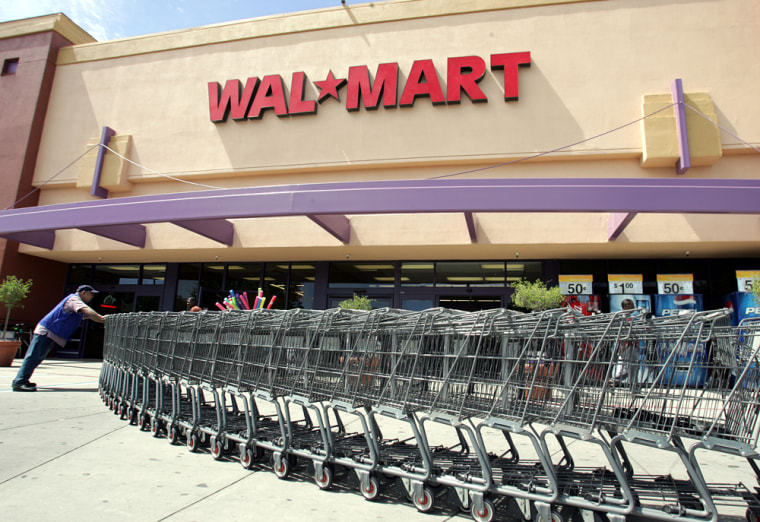Forget Ben Bernanke. Does anything move markets these days more than a monthly same-store sales report from Wal-Mart?
Time and again, traders work themselves into a frenzy, buying or selling based on whether the world's largest retailer hit its latest comparable-store sales forecast. The presumption is that the result provides a window into not only the health of the retail sector but also consumers' overall spending patterns, which drive two-thirds of the economy.
There's only one problem — evidence shows that the presumption is wrong.
An analysis comparing Wal-Mart Stores' same-store sales growth to consumer spending data dating back to January 2004, compiled by the Bureau of Economic Analysis, actually shows a negative correlation between the two. During the first four months of 2006, for example, each month brought a minimum 6 percent hike in consumer spending from the corresponding month in 2005, while Wal-Mart's year-over-year comp sales were bouncing from as low as 0.9 percent to as high as 4.3 percent.
And a similar comparison of Wal-Mart's comp sales to the Conference Board's consumer confidence reading showed almost no correlation between those two measurements either.
Still, Wal-Mart's size, together with the longtime acceptance of same-store sales as a yardstick of a retailer's health, makes for potential fireworks every time the company's executives put out the latest monthly number.
Some retail experts say that a mature company such as Wal-Mart, with over 3,200 stores, is bound to see its comp store sales slow down as it builds multiple locations in many markets. The practice may cannibalize sales in some of its older stores, they say, but it succeeds in building a bigger overall share of markets the company already occupies.
"It's a false premise," says retail expert Britt Beemer of America's Research Group on the notion of Wal-Mart's same-store sales as a valid economic measurement. Target, with a smaller, more spread-out store base, has an easier time growing same-store sales, he notes. And, he says, it makes sense for Wal-Mart to add service to an area that's outgrowing one store, even if it drags same-store sales a bit.
"The two biggest complaints Wal-Mart gets are that their checkout lines are too long and that their aisles are too crowded," Beemer says. Indeed, what shopper stuck in a long line doesn't love the sound of a cashier's voice saying, "I can help you over here," as she opens a new checkout stand? Wal-Mart's expansion of its store networks means simply that it has perfected a way to open more checkout lines a few miles away.
But industry analysts' obsession with comp-store sales continues to keep Wal-Mart's stock down while playing havoc with the industry.
Over Memorial Day weekend, Wal-Mart disappointed investors by announcing 2.6 percent same-store sales growth. That result was "toward the low end of its previous forecast," a phrase that's been used so often with Wal-Mart it's begun to take on cult status in the American economy.
Sure enough, when stock markets reopened on Tuesday, May 30, Wal-Mart led a major selloff by tanking almost 3 percent. The Dow dropped 184 points; all 30 components fell for the first time since September 2004. Reports blamed the effect of gas prices and interest rates on consumer spending. Analysts were using Wal-Mart's sales report as the barometer. Other major retailers naturally got caught up in the frenzy, with shares of Home Depot, J.C. Penney, Best Buy, Costco and Gap all down 2 percent or more.
But the pundits had to eat crow a day later, since only Gap lived down to expectations inaugurated by Wal-Mart when other major retailers reported their own May sales. Same-store sales at J.C. Penney and Anne Taylor Stores were up 11 percent and 12 percent, respectively, while Limited Brands rose 7 percent. Wal-Mart's discount competitors, Target (up 6 percent) and Costco (up 10 percent), also showed few signs of following their bigger rival in lackluster same-store sales.
Overall retail store sales rose 4.1 percent from May 2005, according to the International Council of Shopping Centers, well above Wal-Mart's clip. So much for Wal-Mart's announcement being a bellwether for the industry.
By missing its comp sales targets — Wal-Mart's growth has been below 3 percent for eight of the past 12 months — the retailer has disappointed investors despite its continued surge in overall sales and profit. Wal-Mart grew earnings per share by 29 percent over 2004 and 2005, not far below the 36 percent pace of all S&P 500 firms. But while the S&P 500 index rose 12 percent over that span, Wal-Mart shares dropped 11 percent (they've been flat so far in 2006).
But experts say the focus on same-store sales has given too little credit to a company that has been successfully growing profit — not just revenue — through store expansion.
"Wal-Mart comps say nothing about earnings. I have no concerns about them at all in this [high interest rate] environment," says retail analyst Richard Hastings of Bernard Sands. He points out that the supermarket business, which now accounts for about a third of the company's $300 billion in annual sales, according to industry tracker Retail Forward, provides the advantage of high market penetration. Supermarkets may carry low margins that reduce the same-store sales numbers, but they don't reduce profit.
Neither do Wal-Mart's same-store sales say too much about the economy and consumer spending. If anything, when interest rates are rising and inflation in showing its face, discount shoppers are more likely to remain discount shoppers.
"A low-income family may delay buying their child a bike, but they will still get their milk and other things they need at Wal-Mart," Hastings says.
